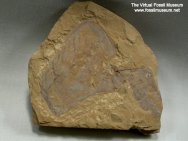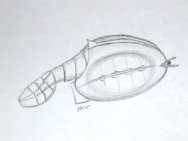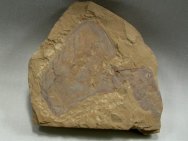Name: Vetulicola
cuneata
Phylum
Vetulicolia (extinct) More
Chengjiang Vetulicolia
Geological
Time: Early Cambrian (~525 million years ago)
Size: 77
mm long by 25 mm across on a 60 mm by 58 mm mat
Fossil Site:
Chengjiang Maotianshan Shale, Quiongzhusi
Section, Yu’anshan Member, Heilinpu Formation Mafang Village, Haikou
County, Yunnan Province, China
|  This
unusual fossil is an example of Vetulicola cuneata (also spelled
cuneatus), a member of the Vetulicolians, an enigmatic group which
some scientists place in their own phylum (Phylum Vetulicolia).
They are thought to have been swimmers that either were filter feeders
or detritivores. One researcher places This
unusual fossil is an example of Vetulicola cuneata (also spelled
cuneatus), a member of the Vetulicolians, an enigmatic group which
some scientists place in their own phylum (Phylum Vetulicolia).
They are thought to have been swimmers that either were filter feeders
or detritivores. One researcher places them with the Urochordates, giving them strong affinity with the
Phylum Chordata.
At present, there is no agreement as to their systematic placement.
This specimen comes from the Chengjiang
Biota, and is thus slightly older than the Burgess Shale Fauna
of British Columbia. The closeup shows the diamond-shaped openings
that allowed water to pass out of the interior. They served either
a respiratory or filter-feeding function. The abdomen is to the
right and bent back along the carapace. If fully stretched out,
this specimen would approach 7 cm. The Chengjiang
fossils comprise the oldest, diverse metazoan faunal assemblage
above the Proterozoic-Phanerozoic transition, and thus the fossil
record’s best data source for understanding the apparently
rapid diversification of life known as the Cambrian
Explosion.
them with the Urochordates, giving them strong affinity with the
Phylum Chordata.
At present, there is no agreement as to their systematic placement.
This specimen comes from the Chengjiang
Biota, and is thus slightly older than the Burgess Shale Fauna
of British Columbia. The closeup shows the diamond-shaped openings
that allowed water to pass out of the interior. They served either
a respiratory or filter-feeding function. The abdomen is to the
right and bent back along the carapace. If fully stretched out,
this specimen would approach 7 cm. The Chengjiang
fossils comprise the oldest, diverse metazoan faunal assemblage
above the Proterozoic-Phanerozoic transition, and thus the fossil
record’s best data source for understanding the apparently
rapid diversification of life known as the Cambrian
Explosion.
|
|






